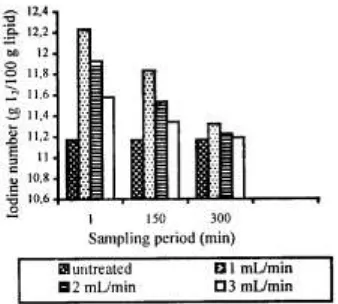Menara Perkebunan, 2000, 68(1) 30 – 38
Continuously increasing of unsaturation level of crude palm oil
using fermentation broth of Absidia corymbifera
Peningkatan ketidakjenuhan minyak sawit kasar secara kontinyu menggunakan cairan fermentasi Absidia corymbifera
TRI-PANJI
Biotechnology Research Unit for Estate Crops, Bogor 16151, Indonesia
Ringkasan
Absidia corymbifera merupakan fungi penghasil asam lemak takjenuh majemuk yaitu asam linoleat dan asam y-linolenat. Produksi asam lemak jenis ini berkaitan dengan aktivitas enzim desaturase yang terdapat balk di dalam sel maupun di dalam cairan fermentasi (di luar sel). Enzim ini berpotensi untuk dimanfaatkan dalam biokonversi enzimatik guna meningkatkan ketidakjenuhan minyak sawit kasar (CPO). Penelitian ini bertujuan meningkatkan ketidakjenuhan minyak sawit kasar melalui biokonversi enzimatis secara kontinyu menggunakan cairan fermentasi Absidia corymbifera Pertama, fungi ini dikulturkan dalam media cair mengandung CPO dengan suplemen garam tertentu menggunakan bioreaktor film permukaan. Setelah inkubasi, biomassa fungi disaring dan sisa CPO dipisahkan. Cairan fermentasi diisikan ke dalam kolom gelas dan CPO dipompakan dari bagian bawah kolom menggunakan pompa peristaltik Analisis komposisi asam lemak dilakukan terhadap CPO sebelum dan setelah bio-konversi serta terhadap lipid biomassa. Karakterisasi lipid dilakukan terhadap CPO sebelum dan setelah biokonversi, meliputi angka asam, angka iod, dan angka penyabunan. Hasil penelitian menunjukkan bahwa cairan fermentasi A. corymbifera mampu meningkatkan ketidakjenuhan CPO dan kandungan asam lemak talfenuh majemuk Peningkatan ketidakjenuhan berkurang selama proses biokonversi kontinyu yang diduga disebabkan menurunnya aktivitas enzim desaturase. Angka asam dan angka penyabunan tidak meningkat secara nyata yang menunjukkan bahwa pada proses tersebut tidak terjadi pemecahan gliserida dari CPO.
Summary
before and after bioconversion as well as to lipid biomass. Lipid characterization was carried out for CPO before and after bioconversion, including acid, iodine and saponification numbers. The results showed that fermentation broth of A. corymbifera was capable of increasing unsaturation level CPO and the content of polyunsaturated fatty acids. Desaturation process decreased during bioconversion which was possibly caused by the decrease of activity of desaturase enzyme. Acid and saponification numbers did not increase significantly, indicated that hydrolysis glyceride of CPO did not occur.
[Keywords: Absidia corymbifera, fermentation broth, desaturase enzyme, continuous desaturation, polyunsaturated fatty-acids, y-linolenic acid, linoleic acid]
Introduction
The unsaturation level of lipid could be chemically defined as the number of carbon-carbon double bond per unit weight of lipid. This parameter depends on the concentration of unsaturated fatty acids as well as the degree of unsaturation of these fatty acids. CPO with higher unsaturation level has several advantages such as (a) increment the amount of olein fraction as raw material for frying oil, (b) increase competitiveness with other vegetable oils, (c) ease of transfer from one tanker to another during transportation and shipping, (d) useful alternative as raw material for medical and pharmaceutical compounds, and (e) increase the quality of CPO (Tri-Panji, 1999b). Polyunsaturated fatty acids (PUFA) are commercially important because the level of these fatty acids acting as antioxidants increases the oxidative stability and nutritional value of seed oils (Yadav et al., 1993). Moreover, some polyunsaturated fatty acids are essential and have various medical uses (Biagi et al., 1988; Horrobin, 1983; Ishikawa et al., 1989; James & Carter, 1988).
Some fungi of the order Mucorales in the class Zygomycetes, such as A. corymbifera and Rhizopus spp. produced polyunsaturated fatty acids (PUFA), namely linoleic and 'Y-linolenic acid, intracellularly and extracellularly in media containing CPO (Suzuki, 1991; Tri-Panji, 1998; 1999b). However the use of these fungi for increasing unsaturation level of CPO through fermentation faces a problem in the increase of concentration of free fatty acids that reduces the quality of CPO (Tri-Panji, 1998).
Fermentation broth of these fungi is assumed to be containing desaturase enzyme which could increase unsaturation level of CPO as proved by increasing its iodine number as well as its concentration of unsaturated fatty acids (Tri-Panji, 1999b). Desaturase enzyme is very unstable (Suzuki, 1991), so that isolation of this enzyme will be difficult. On the other hand, the use of fermentation broth of Ai, corymbifera may be an alternative method for desaturation of lipids.
In this research, a model of continuous desaturation of CPO using fermentation broth of A. corymbifera was developed. The continuous process will allow the desaturation could be run automatically, so that the process could be developed in industrial scale.
Materials and Methods
Figure 1. Diagram of continuously increasing unsaturation level of CPO
in five Erlenmeyer flasks and shaken for 72 h. The cultures were united, then aseptically homogenized with a blender for about one min. and 1,000 mL of the homogenate was inoculated into four plastic trays (35x25x4 cm3) containing 2.5 L modified medium of lipid accumulation of Serrano-Carreon et al. (1993), with medium thickness of about 2.5 cm. This medium composed of (in g/L medium): CPO, 10; (NH4)2SO4, 0.94; KH2P04 7; Na2HPO4. 21120, 2.5070; MgSO4. 71120, 1.5; CaC12, 0.0041; and ZnSO4.7H20 0.0002, then added with one mL/L emulsifier Tween-80, and adjusted to pH 5 by addition of 6N HCI solution. The culture was then incubated at room temperature for 72 h after inoculation. After incubation, fungal mycelium was filtered and dried in an oven at 600C for 24 h. Residual CPO in fermentation broth was separated by cooling the mixture at about 50C in a refrigerator for 2 h and then filtered
varied at one mL/min, two mL/min and three mL/min. The CPO overflowed from the outlet of the column was sampled at 1, 150, and 300 min from the first time of overflowing.
CPO before and after bioconversion was separated from fermentation broth, and then the iodine, acid and saponification numbers of the CPO were analyzed using the method of AOAC (1984). Fatty acid composition of the CPO before and after bioconversion at optimum condition as well as of fungal biomass were analyzed by chromatographic method using a Perkin-Elmer gas chromatograph equipped with FFAP capillary column (25m x 0.25 mm i.d.) as described by TriPanji et al. (1994). Similar experiments were conducted with two and three columns that were connected in a series to prolong the retention time of CPO in the column as well as the contact time between CPO and fermentation broth. Experiments were conducted twice.
Results and discussion
Iodine number of CPO increased from about 11.2 to about 12.2 (g lZ/1009 lipid) after CPO was passed through fermentation broth of A. corymbifera with pumping rate of one mL/min. (Figure 2). This evidence suggests that the fermentation broth contains desaturase enzyme. To the best of my knowledge, this is the first report on the use of desaturase enzyme from fermentation broth of fungus for increasing unsaturation level of CPO. A lesser increase of iodine number occurred when pumping rate of CPO was increased from one mL/min. to three
mL/min, probably because the contact time between substrate (CPO) and the desaturase enzyme was shorter.
Figure 3. Acid number of CPO before and after enzymatic bioconversion using fermentation broth of A. corymbifera in single column at different pumping rate of CPO and different sampling period.
Desaturase enzyme was very unstable in homogenate (in vitro) as shown in the lesser increase of iodine number of the sample at sampling period of 150 and 300 min. compared to that obtained at sampling period of one min. Activity of desaturase enzyme remained 5-15 % of the original value after it was used for CPO bioconversion in 300 min. Similar evidence was reported by Suzuki (1991) who examined the activity of the enzyme of Mortierella rammaniana var. angulispora (IFO 8187) by adding metal ion and decreasing temperatures in vitro.
Acid number of CPO increased during desaturation, probably because of the hydrolysis of CPO glycerides. CPO was also un-stable during storage as reflected in the higher increase of its acid number at longer sampling period (Figure 3). At sampling period of one min. and at pumping speed of one mL/min., the increase of acid number of CPO was not significant, whereas at sampling period of 300 min. at the same pumping speed acid number increased about 0.5 mg KOH/g lipid. This evidence suggests that the increase of acid number is affected by the storage rather than by the contact between CPO and fermentation broth.
Figure 4. Saponification number of CPO before and after enzymatic bioconversion using fermentation broth of A. corymbifera in single column at different pumping rate of CPO and different sampling period.
.
Figure 5. Iodine number of CPO before and after enzymatic bioconversion using fermentation broth of A. corymbifera in different column series at pumping rate of CPO I mL/min. at different sampling period.
Figure 6. Acid,, number of CPO before and after enzymatic bioconversion using fermentation broth of A. corymbifera in different column series at pumping rate of CPO I mL/min. at different sampling period.
while the latter can be overcome by enzyme immobilization. In addition, immobilized enzyme is also more stable than the free one. In general, techniques for cell immobilization are cheaper and easier to carry out than for enzyme immobilization (Tampion & Tampion, 1987).
By using a series of three columns, the increase of acid number is less than 0.3 mg KOH/g lipid at sampling period of one min. An increase of acid number as much as 1.2 mg KOH/g lipid (increase 4% from original acid number) was observed at sampling period of 300 min. with the same column series, while by using a series of two columns at the same sampling period, the increase of acid number was less than 0.5 mg KOH/g lipid (Figure 6). The increase in acid number is relatively low. However, more columns or longer retention time of CPO in the column, along with longer storage time, may cause undesirable increase in free fatty acid content. These results also suggests that optimum number of column series is two. At this condition, change in iodine number is as much as 1.4 g IZ/1009 lipid.
Changes in saponification dumber for all series of columns were not more than about 0.1 mg KOH/g lipid (0.8%) (Figure 7) indicating that saponification number was practically unaffected by this short process. A significant increase in saponification number is observed when CPO was used as a fermentation substrate for fungi producing polyunsaturated fatty acids (Tri-Panji, 1999b), which may be due to the relatively longer period of process.
Figure 7. Saponification number of CPO before and after enzymatic bioconversion using fermentation broth of A. corymbifera in different column series at pumping rate of CPO 1 mL/min. at different sampling period.
Table 1. Fatty acid composition of A. corymbifera biomass and of CPO before and after enzymatic bioconversion using fermentation broth of A. corymbifera.
Percentage of area of fatty acid methyl esters (%) Lipid sample from
C14:0 C16:0 C16:1 C18:0 C18:1 C18:2 C18:3, or Fungal biomass - 18.8 1.8 6.3 57.4 12.9 2.8 Residual CPO after fermentation - 52.4 25.6 6.1 4.9 4.9 6.1 Sterilized CPO + fermentation broth
+Tween-80 - 0.1 35.8 - - 28.3 35.8
Unsterilized CPO + fermentation - 0.3 15.3 - - 76.7 7.7 broth + Tween-80
Control:
- Sterilized CPO+ sterilized
aquadest 15.8 50.6 - 11.9 12.1 5.9 3.7 + Tween-80
- Unsterilized CPO + sterilized 20.1 61.1 - ` 3.1
7.8 4.4 3.5 aquadest + Tween-80
- : undetectable
concentration of unsaturated fatty acids and the decrease of concentration of saturated fatty acids is in accordance with the increase of iodine number of CPO during desaturation by fermentation broth of A. corymbifera.
Conclusion and Suggestion
1. Fermentation broth of A. corymbifera was capable of increasing unsaturation level of CPO by increasing the concentration of unsaturated fatty acids including linoleic and linolenic acid and decreasing the concentration of saturated fatty acids.
2. The use of fermentation broth of A. corymbifera is potential to be developed in countinuously increasing concentration of polyunsatutared fatty acids of CPO.
3. The problem of unstability of desaturase enzyme in fermentation broth of A. corymbifera should be overcome to optimize the yield of polyunsatutared fatty acids. Enzyme immobilization may be an alter-native method to overcome this problem.
References
AOAC (1984). Methods ofAnalysis ofAssociation of Ojfcial Agricultural Chemist 5th ed. Washington, AOAC Publ., p 507-508.
Biagi, P.L., A. Bordoni, M. Masi, G. Ricci, C. Fanelli, A. Patrizi & F. Ceccolini (1988). Evening primrose oil (Efamol) in thetreatment of children with atopic eczema. Drug Exptl. Clin. Res., 14,291-297.
Horrobin, D.F. (1983). The role of essential fatty acids and prostaglandins in the premenstrual syndrome. J. Reprod Med, 28,465-268.
Ishikawa, T., Y. Fujiyama, C. Igarashi, M. Morino, N. Fada, A. Kagami, T. Sakamoto, N. Nagano & H. Nakamura (1989). Clinical features of familial hypercholesterolemia. Atherosclerosis, 75, 95.
James, P. & M.D. Carter (1988). Gamma linolenic acid as a nutrient. Food Technol., 42, 72-82.
Serrano-Carreon, L., Y. Hathout, M. Bensoussan & J.M. Belin (1993). Metabolism of linolenic acid or mevalonate and 6-pentyl-apyrone biosynthesis by Trichoderma species. Appl. Environ. Microbiol., 59(9),2945-2950.
Suzuki, O. (1991). Recent trends of oleochemicals by biotechnology. In PORIM International Palm Oil Conference - Chemistry, and Technology. Malaysia, 221230.
Tampion, J. & M. D. Tampion (1987). Immobilized Cell: Principles and Application. Cambridge University Press. Cambridge, p 5.
Tri-Panji, S.S. Achmadi & E. Tjahjadarmawan (1997). Production of y-linolenic acid from Absidia corymbifera cell biomass. In Proc. The Indonesian Biotech. Conf., Jakarta, June 17-19, p 391-400.
Tri-Panji (1998). Peningkatan kandungan asam lemak takjenuh majemuk pada minyak sawit melalui fermentasi dan biokonversi enzimatik menggunakan Absidia corymbifera. In Pros. Pertemuan Ilmiah Tahunan PERMI 1998, Lampung, 14-15 Desember 1998. p. 81-90.
Tri-Panji (1999a). Produksi asam lemak takjenuh majemuk dari Absidia corymbifera meng-gunakan bioreaktor film permukaan. In Pros.Pertemuan Ilmiah Tahunan PERMI 1999, Padang, 2-3 Agustus 1999 p. 466-474.
Tri-Panji (1999b). Increasing unsaturation level of crude palm oil through enzymatic biocon-version using Rhizopus oryzae. Menara Perkebundn, 67 (1), 52-58.





